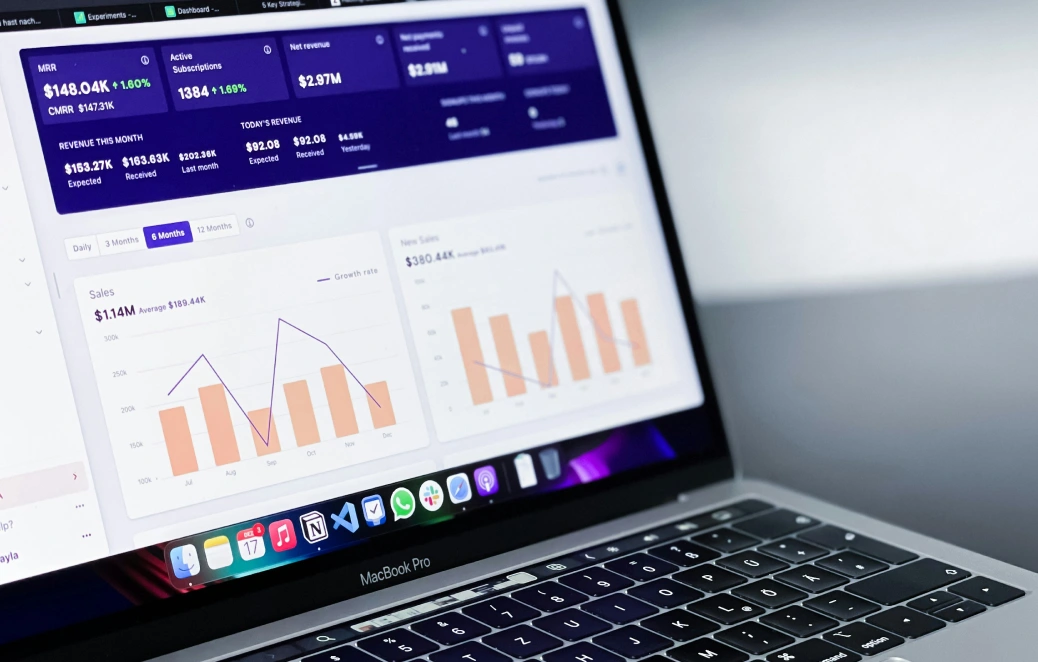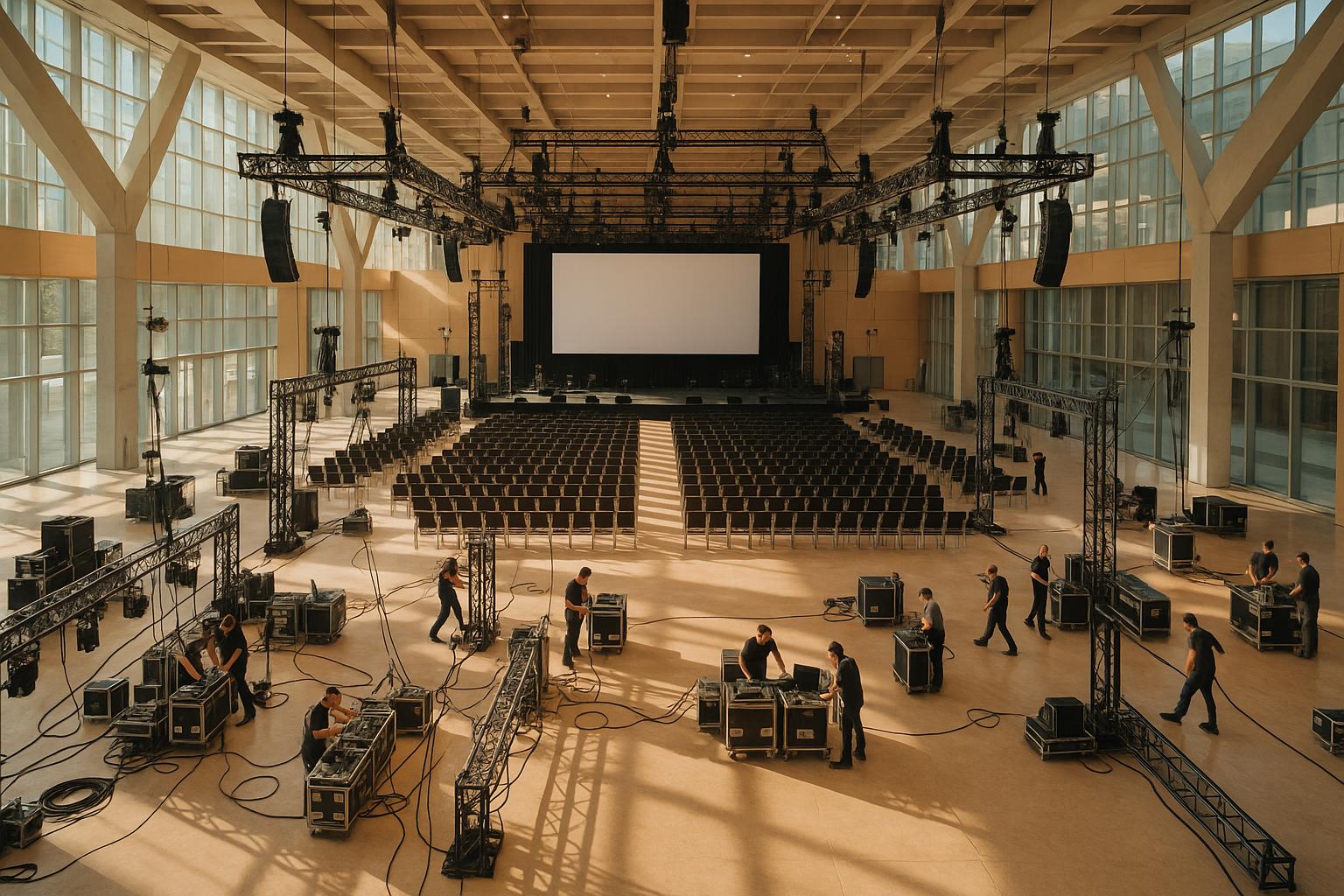Best Practices For Hybrid Meeting Planning

Chief Executive Officer

Hybrid meetings are now standard, blending in-person and remote participants to accommodate modern workforce needs. To make these meetings successful, focus on four key areas:
- Preparation: Define clear goals, create detailed agendas, and share materials in advance. Ensure both in-person and remote participants feel equally included.
- Technology: Choose reliable platforms with features like high-quality video, live captions, and seamless integration with hardware. Test everything beforehand to avoid technical issues.
- Engagement: Use tools like digital whiteboards, live polls, and Q&A features. Arrange physical spaces thoughtfully, and assign roles to ensure everyone has a voice.
- Follow-Up: Collect feedback within 24 hours, share recordings with timestamps, and analyze participation data to improve future meetings.
Hybrid meetings require thoughtful planning and execution. By addressing each of these areas, you can create a balanced experience for all participants, regardless of location.
Effective Hybrid Meetings: A How-To Guide
Planning Your Hybrid Meeting Foundation
Getting the basics right is the key to ensuring your hybrid meeting brings people together instead of leaving them frustrated.
Setting Clear Goals and Understanding Your Audience
Before locking in a meeting, take a moment to ask yourself: Is this meeting absolutely necessary? Sometimes, a quick email or an asynchronous discussion can save time and reduce the dreaded meeting fatigue.
If a meeting is the best option, make sure you have clear objectives in mind. What decisions need to be made? What outcomes are you aiming for? Once you’ve nailed these down, weave them into a well-structured agenda.
Keep in mind that in-person and remote attendees experience meetings differently. Remote participants often need extra support to feel included and engaged.
"The goal is to start a pattern where location does not determine level of participation. The on-site and the remote participants should contribute equally to a meeting." - University of Toronto – Digital Learning Innovation
It’s also important to consider the unique circumstances of your participants. Some may be managing caregiving responsibilities, dealing with health challenges, or navigating language differences. Acknowledging these factors helps you create a space where everyone feels welcome and valued.
Creating Agendas and Sharing Materials
A clear agenda is the backbone of any successful meeting. Include specific time slots, like "9:00 AM - 9:15 AM EST: Project Updates", to help participants - whether on-site or remote - organize their schedules.
To give everyone a chance to prepare, share meeting materials at least 24 hours in advance. This ensures participants have the time they need to review and contribute meaningfully.
Set expectations upfront in your agenda. Will remote attendees need to keep their cameras on? How will questions be handled - through a raised hand feature or the chat box? Should participants mute themselves unless speaking? Laying out these ground rules minimizes confusion and keeps the meeting running smoothly.
Don’t forget about communication logistics. Plan how in-person attendees will share their input - whether that’s by using a microphone or following a specific speaking order. At the same time, ensure that materials and information are easily accessible to remote participants. A well-thought-out communication plan makes the meeting more inclusive and accessible for everyone involved.
Choosing Venues and Room Layouts
Accessibility should be a top priority when selecting your venue. Swap out physical tools like whiteboards for digital collaboration platforms that everyone - whether in the room or miles away - can use. This approach not only levels the playing field but also ensures your technology works seamlessly in a hybrid setting.
Using Technology for Better Integration
Once you've nailed down your meeting's goals and logistics, the next step is making technology work for you. A solid tech setup is the backbone of any successful hybrid meeting, bridging the gap between in-person and remote participants.
Choosing the Right Platforms and Tools
The platform you choose can make or break your hybrid meeting. Look for one that offers high-quality video, clear audio, and reliable screen sharing. These features ensure remote attendees can follow along without struggling to see or hear what's happening.
Accessibility should be a top priority. Platforms that include live captioning and transcription services allow participants with hearing impairments to stay fully engaged. Many tools now offer real-time captions automatically, removing the need for extra setup.
Another key consideration is how well the platform integrates with your existing equipment. It should work smoothly with room cameras, microphones, and display screens. When all the tech aligns, you avoid those awkward delays that disrupt the flow of a meeting.
For organizations unsure about the right tools, companies like Corporate Optics specialize in tailoring technology solutions to specific needs. Their expertise in technical event production ensures your platform choices enhance rather than hinder your meeting goals. Once you've chosen your platform, test it thoroughly to avoid surprises.
Testing Your Tech Ahead of Time
Never assume everything will work perfectly on the day of the meeting. A tech rehearsal 24 hours before the event can help you catch and resolve issues before participants join.
Check your internet connection, audio equipment (like microphones and speakers), and visual elements (such as camera angles and lighting). Weak WiFi or dead zones can derail a presentation for remote attendees, so always have a backup plan, like a mobile hotspot or secondary internet source.
Audio quality is especially critical. Make sure in-person voices are clear to remote participants and vice versa. Poor acoustics can lead to echo or muffled sound that immediately frustrates virtual attendees.
Visual clarity matters too. Remote participants should easily see in-person attendees and any shared materials. Proper lighting is essential - dim or shadowy setups can unintentionally create a disconnect.
Leveraging AI and Analytics for Better Meetings
Once you've got the basics covered, advanced AI tools can take your hybrid meetings to the next level. Artificial intelligence is reshaping how meetings are managed, making them more efficient and productive.
AI-powered transcription tools can generate real-time meeting notes, capturing decisions and action items automatically. This eliminates the need for a dedicated note-taker and ensures nothing gets overlooked.
AI can also help manage your agenda. For example, smart agenda tools can track speaking time, suggest when to move to the next topic, and even monitor engagement levels to keep the meeting on track.
Corporate Optics incorporates AI tools like prompts.ai to automate agenda tasks and gather real-time engagement data. These tools streamline the meeting process, ensuring everything runs smoothly.
After the meeting, analytics tools provide valuable insights. You can review metrics on participant engagement, speaking patterns, and content effectiveness. These insights highlight which parts of your meeting resonated and where you might need to improve. AI can even track participation rates between in-person and remote attendees, helping you ensure both groups feel equally included.
One particularly exciting development is live sentiment analysis. This technology can gauge audience reactions in real-time, alerting you if engagement drops or if participants seem confused. With this information, you can adjust your approach on the spot to keep everyone engaged.
sbb-itb-ae35a94
Keeping Hybrid Audiences Engaged
Once you’ve got the tech side sorted, the next big challenge is keeping everyone involved - whether they’re in the room or dialing in remotely. With Cisco reporting that nearly all meetings (98%!) now include at least one remote participant, finding ways to keep everyone engaged isn’t just a nice-to-have - it’s essential.
Encouraging Interactive Participation
Here’s a simple but effective rule: one person, one screen. This ensures that everyone - whether in-person or remote - has an equal presence in the meeting. When in-room participants huddle around a single camera, remote attendees can feel like they’re on the outside looking in.
To make sure everyone’s voice is heard, assign roles like a virtual participant advocate. This person keeps an eye on the chat and makes sure remote attendees aren’t overlooked. Rotating the role of facilitator also helps share responsibility and keeps the dynamic fresh.
Want to hear more from quieter team members? Use chat backchannels. They’re a great way for participants to share questions or thoughts without interrupting the flow of conversation. And if someone who usually joins remotely takes the lead for a meeting, it gives the team a firsthand look at the challenges and opportunities of the virtual experience.
Pair these strategies with digital tools to make participation even more seamless.
Adding Digital Engagement Tools
Interactive tools can turn passive listeners into active collaborators. For example:
- Digital whiteboards like Miro or Microsoft Whiteboard let everyone brainstorm together in real time, whether they’re adding sticky notes, drawing connections, or voting on ideas.
- Live polling tools like Slido or Poll Everywhere allow you to gather instant feedback from the entire group. Instead of a quick show of hands, a poll provides clear, actionable insights on the spot.
- Built-in Q&A features make managing questions a breeze. Participants can submit their questions as they come to mind, and the facilitator can address them during natural breaks.
These tools don’t just add flair - they drive results. For instance, one company saw a 40% jump in participation during a hybrid town hall by using live polls. Leadership was able to gauge employee sentiment in real time, making the meeting far more productive.
Companies like Corporate Optics specialize in integrating these tools into hybrid events, ensuring they enhance the experience rather than complicate it. Their expertise helps organizations find the right mix of tools to suit their needs.
Of course, while digital tools are great for boosting virtual engagement, the physical setup of your meeting space plays an equally important role.
Setting Up Physical and Virtual Spaces
The way you arrange your meeting space can make a big difference in how connected everyone feels. A U-shaped or semi-circle seating arrangement works well in rooms at least 12 x 20 feet in size. This setup ensures clear sightlines to cameras and displays, making it easier for remote participants to pick up on facial expressions and body language.
Audio and video clarity are non-negotiable. Place microphones and cameras at eye level, about 3–6 feet from speakers, to avoid any awkwardness or technical hiccups. Large displays (at least 65 inches) help remote participants feel like they’re truly part of the conversation, not just a tiny box in the corner of the screen.
Virtual meeting platforms can also mimic in-person experiences with features like breakout rooms for smaller group discussions. Tools like live reactions, chat, and digital hand-raising let remote participants engage just as actively as those in the room. Encouraging everyone to keep their cameras on adds another layer of connection.
When the physical and virtual spaces are thoughtfully designed, the meeting becomes about collaboration - not about dealing with logistical headaches. By bridging the gap between in-person and remote experiences, you create a space where everyone, regardless of location, can contribute equally.
Post-Meeting Follow-Up and Analytics
The effort doesn’t end when your hybrid meeting wraps up. A thoughtful follow-up process not only maximizes the value of the meeting but also helps identify what worked well - and what didn’t - so you can make improvements for the next one.
Collecting Feedback and Data
Gathering honest feedback from both in-person and remote participants is key to understanding the effectiveness of your hybrid setup. Timing matters - send out feedback requests within 24 hours while the meeting is still fresh in everyone’s mind.
Keep your surveys short and focused, ideally 5 to 7 questions. Zero in on hybrid-specific factors like audio quality, video clarity, participant engagement, and inclusivity. Use a mix of rating scales (e.g., 1-10) for measurable data and open-ended questions for deeper insights. For instance, you might ask: “On a scale of 1-10, how easy was it to follow the discussion?” followed by “What specific challenges did you face during the meeting?”
Digital tools make it easy to compile and analyze feedback quickly. Additionally, track participation data directly from your meeting platform. Metrics like attendance duration, chat activity, and tool usage can reveal patterns. For example, if remote attendees tend to drop off midway while in-person participants remain engaged, that’s a clue something needs adjustment.
For a deeper dive, services like Corporate Optics offer post-event analytics that go beyond attendance stats. Their detailed reports can uncover subtle trends in engagement and participation, helping you refine your hybrid meeting strategy.
Finally, keep the momentum going by promptly sharing recordings and summaries.
Sharing Recordings and Summaries
Distribute meeting recordings and summaries within 48 hours to maintain engagement and ensure everyone stays aligned. Timely follow-up respects participants’ time and keeps projects on track.
When sharing recordings, include a clear outline with timestamps for key topics and action items. For example, instead of sending a 90-minute video with no context, provide a guide like this:
- Budget discussion: 12:30–25:45
- Q4 planning: 25:45–48:20
- Action items: 48:20–52:10
This makes it easy for team members to locate the information they need without watching the entire recording.
Written summaries should be concise but thorough. Highlight key decisions, assigned tasks, and next steps. Use a consistent format that includes the meeting date (e.g., 10/15/2025), attendee list, main outcomes, and specific deadlines. For instance, instead of writing, “Sarah will follow up on the budget,” say, “Sarah will send updated budget projections to the team by Friday, 10/20/2025, at 5:00 PM EST.”
Once materials are shared, it’s time to use analytics to refine future meetings.
Using Analytics to Improve Future Meetings
Feedback and participation metrics are invaluable tools for improving your hybrid meetings. Look for trends across multiple meetings rather than basing changes on isolated incidents.
Track key metrics like attendance, engagement levels, and technical performance. If remote participants frequently leave early or remain silent during discussions, it’s a sign that engagement strategies need revisiting.
Consider how different meeting formats affect outcomes. For instance, your team might collaborate more effectively during hybrid brainstorming sessions but prefer fully remote setups for routine status updates. Or you might discover that certain times of day work better for participants in different time zones. These insights can guide smarter decisions about when and how to use hybrid formats.
Corporate Optics offers detailed analytics to help organizations identify these patterns. Their reports include engagement metrics, technology performance data, and actionable recommendations for future improvements, giving you the tools to make data-driven decisions instead of relying on guesswork.
To track progress over time, create a simple system for monitoring key metrics. Use a spreadsheet to log satisfaction scores, technology issues, and participation rates for each meeting. After six months, you’ll start to see clear trends that can shape your hybrid meeting strategy.
Key Takeaways for Hybrid Meeting Success
To pull off successful hybrid meetings, you need a clear plan that focuses on four main areas: preparation, technology, engagement, and follow-up. Let’s break it down.
Foundation and preparation are where it all starts. Begin with clear goals to decide the right meeting format. Think about your audience - what works for in-person attendees might not work for remote participants, so design with both in mind. Share detailed agendas and materials ahead of time to keep everyone on the same page. Don’t overlook the physical setup either. Good lighting, proper acoustics, and well-placed cameras can make remote attendees feel just as involved as those in the room.
Technology integration is what keeps everything running smoothly. Choose a platform that meets your needs, whether it's for breakout rooms, screen sharing, or real-time collaboration. Always test your tech beforehand to avoid hiccups. Tools like AI-powered platforms and analytics, such as Corporate Optics, can help you identify what’s working and what’s not.
Engagement strategies are crucial to bridging the gap between in-person and remote participants. Rotate speakers, use digital polls, and encourage interaction to ensure everyone has a voice. Aligning camera angles, lighting, and audio ensures clear communication for both groups.
Follow-up and continuous improvement ensure each meeting builds on the last. Gather feedback within 24 hours and use analytics to refine your approach. Share meeting recordings with timestamps and summaries within 48 hours to keep projects moving forward. Analytics can also help you spot trends and make data-driven adjustments for future meetings.
The companies that excel at hybrid meetings treat them as an ongoing skill to master, not just a quick fix. They invest time in understanding the unique dynamics of managing both in-person and remote audiences. By focusing on these four pillars, they create systems that make hybrid meetings effective, scalable, and repeatable.
FAQs
What are the best ways to make remote participants feel included in a hybrid meeting?
To ensure remote participants feel genuinely included in a hybrid meeting, it's crucial to create an environment where everyone can engage on equal footing. Start by using high-quality cameras and microphones in the meeting room. Clear visuals and audio make it easier for virtual attendees to stay connected and actively participate in the discussion.
Boost interaction by incorporating tools like chat, polls, or Q&A features, and appoint a facilitator to focus on remote engagement. This way, questions and contributions from virtual attendees are addressed promptly. Even small gestures, such as speaking directly to both in-person and remote participants, can make a big difference in fostering a sense of inclusion and collaboration.
How can I collect and use feedback effectively after a hybrid meeting?
Gathering and applying feedback after a hybrid meeting is a crucial step to make future sessions more effective. Start by sharing brief post-meeting surveys with open-ended questions. These surveys should be easy to access for both in-person and virtual attendees, ensuring everyone has the opportunity to share their experiences and suggestions.
Offer multiple ways for participants to provide feedback, such as follow-up emails or anonymous forms. This flexibility encourages honest input and ensures that everyone feels comfortable sharing their thoughts. Use the feedback to adjust meeting formats, tackle any issues, and create an environment that’s more engaging and inclusive for all participants. Collecting feedback thoughtfully can lead to smoother meetings and stronger collaboration going forward.
What tools or technologies can help make hybrid meetings more engaging?
To bring more energy and involvement to hybrid meetings, try incorporating interactive tools like live polls or quiz platforms. These can spark real-time participation and keep everyone actively engaged. Additionally, using shared digital whiteboards and collaborative document editing tools can help unify in-person and remote participants, making teamwork feel seamless.
By integrating these tools, meetings become more dynamic and interactive, helping everyone feel like an equal part of the conversation, regardless of their location.
Related Blog Posts









